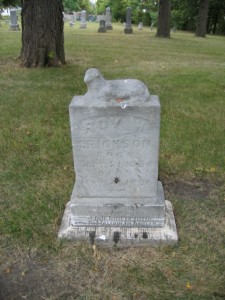
Lambs are often on the gravestones of children depicting youthfulness and innocence. Religious meaning for some is in relation to Biblical verses about the Lamb of God and the Shepherd guding his flock of young lambs and older sheep. Many lambs of Pioneers and Soldiers Cemetery have weathered or disappeared as have approximately 700 other tombstones.
By Sue Hunter Weir
Rampant, communicable diseases caused early deaths now preventable
On the north side of the cemetery, in one of the blocks of graves overlooking the Midtown Greenway, there are nine lots divided into half-size graves. They are children”'s graves, mostly from the early-to-mid 1890s. It”'s not clear why the cemetery”'s owners set aside these special sections for children at that particular time. It may have been to meet the needs of parents who couldn”'t afford full-sized graves but who didn”'t want their children buried in the paupers”' section of the cemetery. It”'s may be that parents found comfort in the idea of their children being surrounded by other children. It may reflect a greater-than-usual mortality rate among young children. It may well have been some combination of all three.
While there are more markers in these sections than the Potters Field, not every grave was marked. Those that were had small markers, usually marble, and often they had three-dimensional carved lambs resting on top of the stones. Minnesota weather has not been kind to those markers and many of the lambs are no longer recognizable as such.
A headline in the August 11, 1895, issue of the Minneapolis Tribune declared that July had been a “Bad Month for Children.” And it certainly was. In June fifty-four children under the age of five had died in Minneapolis. In July, that number had jumped to 158. Forty-five of the children who died in July are buried in Minneapolis Pioneers and Soldiers Cemetery.
Some of them died from the “usual” causes””stillbirths, premature births, or gastrointestinal problems caused by coming into contact with contaminated water. But there was also something else going on that month.
The Health Department reported that there were 376 cases of young children suffering from diphtheria, scarlet fever, measles or typhoid fever. Two hundred and twenty two of those cases were measles. Not all of the children who became sick died but far too many did. What those four diseases had in common is that all of them are communicable. The other thing that they have in common is that they are all preventable now.
Before the measles vaccine was discovered in the early 1960s, it was more or less assumed that most children would get measles, and many did. But if you were to ask people who were alive in the 1950s what they remember as the decade”'s biggest threat to children they are likely to say that it was polio. In fact, twice as many children died from measles as died from polio.
Vaccinating children against measles became the norm during the mid-60s, and by the year 2000 public health officials believed that measles had been eradicated in the United States. They no longer believe that to be the case. New York City is in the midst of a measles outbreak; twenty cases have been diagnosed in the first three months of this year. Thirty-two cases of measles diagnosed in California so far this year and half of those who have been infected were not vaccinated.
By the time that 1895 ended, eighty-three children were buried in one of the nine special sections reserved for them. They accounted for 44% of the burials in the cemetery during that year and that number does not include other children who were buried elsewhere in the cemetery. At that time there was little that their families could do to protect their children. We are fortunate that that is no longer the case.
The children are buried in sections 4-7, 11-14, and 19 of Block T.









